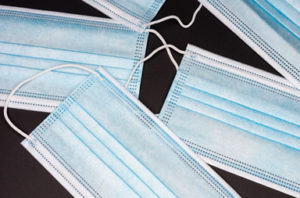Tips for Wearing Masks with Glasses Comfortably

The increase in mask-wearing is necessary for public health, but it can pose a problem for wearers of glasses. Here are some tips for doing so comfortably.

Perhaps it was inevitable, but Aucklanders are now being encouraged to embrace mask-wearing as a way of slowing the spread of Covid-19. Kiwis aren’t as used to this practice as residents of some other parts of the world, so it will take a bit of getting used to, but it’s all for a good cause. Studies suggest that wearing a simple, non-surgical mask can prevent the sick from spreading the virus and the healthy from picking it up.
There’s no denying, however, that there are some inconvenient aspects to wearing masks, and people who wear glasses know these only too well. Whether you’re a full-time wearer of spectacles to correct your vision or simply wear sunglasses against the glare, you may have experienced foggy glasses, feeling uncomfortable with extra pressure around your ears, or your glasses slipping down your nose when you wear them with a mask.
Mask wearing is important, but of course we want to be as comfortable as possible at the same time. Here are some tips for counteracting some of the most annoying aspects of wearing a mask and glasses at the same time.
How to prevent foggy glasses
 This is more of a problem in the winter and the early mornings, when your breath is much warmer than the outside air temperature and your glasses. Warm air escapes from the top of the mask directly onto your lenses, causing them to steam up, just like when you first come out of the bathroom!
This is more of a problem in the winter and the early mornings, when your breath is much warmer than the outside air temperature and your glasses. Warm air escapes from the top of the mask directly onto your lenses, causing them to steam up, just like when you first come out of the bathroom!
There are a few ways you can prevent foggy glasses.
First, keep your lenses clean and smudge-free by wiping them with special lens-cleaning spray and the handy microfibre cloth that comes with new glasses, or even by using soap and water. Keeping them clean won’t prevent foggy glasses entirely, but it will reduce some of the obstructions to good vision. The cleaner the lenses are, the less small droplets will stick to them. Anti-fogging sprays and wipes are also available, and well worth getting if you know you’ll have to wear a mask with glasses a lot.
Second, make sure your mask fits your face well, especially around your nose. Some masks come with bendable wire at the bridge of the nose, which you can mold to the contours of your face. A good, snug fit will prevent some breath from escaping. Alternatively, if you need to wear your mask for longer and you won’t need to take it on and off a lot, or if you have a simple homemade mask, you could try taping your mask to your nose. We recommend surgical tape rather than regular sticky tape, for the sake of your skin!
Depending on the shape of your face, the type of glasses you have (whether they have silicone nose pieces or are made from smooth plastic) and the fit of your mask, you could also try pulling your mask a bit higher up your nose and pushing your glasses down a little. Putting your glasses over your mask may create more of a seal to prevent breath escaping, and creating more space between your glasses and your eyes allows air to circulate more freely. Doing this may be more difficult if your glasses have a tendency to slip down your nose, but if this happens you may need to get your glasses adjusted for fit.
Give your ears a break
 The elastic of masks can create pressure behind your ears that is uncomfortable for anybody, but more so for glasses wearers who already have pressure in that area.
The elastic of masks can create pressure behind your ears that is uncomfortable for anybody, but more so for glasses wearers who already have pressure in that area.
The first solution is to make sure your mask fits you well. If it’s too small then the elastic may be too tight, pulling your ears forward uncomfortably. Yes, you want a snug fit, but ensuring this depends on the shape of the mask itself and not just how tight the elastic sits behind your ears. If you’ve gone down the homemade mask route, test the placement of the elastic before sewing it in.
If that doesn’t work and you don’t mind a bit of fashionable experimentation (and are good with a needle and thread), grab a stretchy cotton headband and sew a large button on either side, above your ears. Instead of looping the mask’s elastic around your ears, loop it behind the buttons. This will take some of the pressure off your ears and skin. If you’ve fashioned a homemade mask you could even create a headband to match. Alternatively, you can find some masks that have fasteners that attach together behind the head, rather than looping around your ears.
Switch to contact lenses
 Although they’re not an option for everybody, if you are able to wear contact lenses–or have never tried but would like to–now is a great time to try. Once you get used to wearing contacts they can feel as though you’re not wearing anything in your eyes at all. You’ll have no problems with foggy lenses or other inconveniences associated with wearing a mask and glasses at the same time. Contacts can be worn all day, every day (just taking them out at night) or for shorter periods, when it’s convenient for you.
Although they’re not an option for everybody, if you are able to wear contact lenses–or have never tried but would like to–now is a great time to try. Once you get used to wearing contacts they can feel as though you’re not wearing anything in your eyes at all. You’ll have no problems with foggy lenses or other inconveniences associated with wearing a mask and glasses at the same time. Contacts can be worn all day, every day (just taking them out at night) or for shorter periods, when it’s convenient for you.
Book in for a contact lens consultation at Greenlane Penrose Optometrist to see whether contacts are a good option for you.
Featured Posts
What’s New in Eyewear Trends 2021?
Whether you wear your glasses all the time or only for certain activities, they become an important part of your look. Just like your clothes, your glasses say a lot about your style…
Put an End to Streaks: How to Clean Your Glasses
Whether you’re a full-time wearer of glasses or just use them for driving or reading, you know how easy it is to smudge the lenses: fingerprints, face cream…
Address
Cnr Great South Road & Rockfield Road, Greenlane 1051
Phone
09 525 1516
Hours
Mon to Fri: 9am – 5pm
Sat to Sun: Closed
Holidays: Closed


